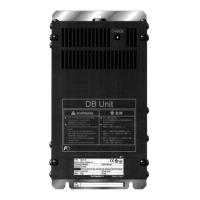FUNCTION CODES
Chap 5
< Initial value of UP/DOWN control when setting method of frequency setting is switched>
The initial value when setting method of frequency setting is set to UP/DOWN control is shown in the following
table.
Setting method prior to
switching
Switching signal
Initial value of UP/DOWN control
H61=0 H61=1
Setting other than
UP/DOWN (F01, C30)
Frequency setting 2/
Frequency setting 1
Reference frequency by setting method prior to switching
PID control PID Cancel Reference frequency by PID control (PID output)
Multistep frequency Multistep frequency
selection
Reference frequency by
setting method prior to
switching
Reference frequency by
previous UP/DOWN control
Communication Link operation selection
[ 4 ] Frequency setting using digital inputs (option DIO interface card) (F01 = 11)
The frequency setting with binary (8,12bit) or BCD code via option DIO interface card (OPC-DIO) is also available
to be selected. Refer to the Digital Input Output Interface Card Instruction Manual.
[ 5 ] Frequency setting using pulse train input (F01 = 12)
■ Selecting the pulse train input format (d59)
A pulse train in the format selected by the function code d59 can give a frequency command to the inverter. Three
types of formats are available; the pulse train sign/pulse train input, the forward rotation pulse/reverse rotation
pulse, and the A and B phases with 90 degree phase difference. If no optional PG interface card is mounted, the
inverter ignores the setting of the function code d59 and accepts only the pulse train sign/pulse train input.
The table below lists pulse train formats and their operations.
Pulse train input format
selected by d59
Operation overview
0: Frequency and direction Frequency/speed command according to the pulse train rate is given to the
inverter. The pulse train sign specifies the polarity of the frequency/speed
command.
• For the inverter without an optional PG interface card
Pulse train input: “PIN” assigned to the digital terminal [X5] (data = 48)
Pulse train sign: “SIGN” assigned to a digital terminal other than [X5]
(data = 49)
If no SIGN is assigned, polarity of any pulse train input is positive.
1: Forward and reverse pulse Frequency/speed command according to the pulse train rate is given to the
inverter. The forward rotation pulse gives a frequency/speed command with
positive polarity, and a reverse rotation pulse, with negative polarity.
2: Quadrature A/B signals
(B phase lead)
Pulse trains generated by A and B phases with 90 degree phase difference
give a frequency/speed command to the inverter based on their pulse rate
and the phase difference (B phase advanced).
3: Quadrature A/B signals
(A phase lead)
When YA, YB are connected in reverse, if you change this function code, the
inverter can receive the pulse signal correctly.
Format of data 1 to 3 refer to d14.
Figure 5.3-1 Data 0, pulse train sign/Pulse train input.

